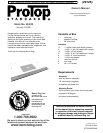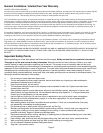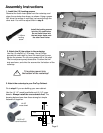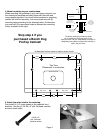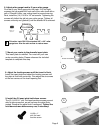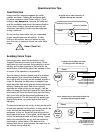
Page 6
Fence
b
i
t
r
o
t
a
t
i
o
n
Fence
Fence
A classic trap resulting in a climb
cut. Always avoid this set-up!
This feed direction will
result in a climb cut because
the stock is trapped between
the fence and the router bit.
NO!
Proper feed direction
b
i
t
r
o
t
a
t
i
o
n
Avoiding Fence Traps
Fence traps occur when the work piece is fully
"trapped" between the router bit and fence. Fence
traps pose two real concerns: the possibility of climb
feeding, and human exposure to the router bit. As
stated earlier, climb cutting should be avoided as loss
of control of the operation is a possibility!
The top drawing shows a classic trap to be avoided.
What appears as a normal feed direction (working
from right to left) is wrong, and will instead produce a
climb cut. Because the work piece is trapped it can
easily be pulled from one's grip and thrown with great
velocity. Feeding the stock from left to right will
eliminate the climb cut but not the danger. It will be
difficult to keep the stock tight against the fence as the
bit's rotation will thrust the stock away from the fence.
Also, your body will be dangerously exposed to the
spinning router bit. The bit guard will not protect you
against flying stock, nor guard against this level of
exposure.
The second drawing is not a trap, as long as the router
bit cuts only partially into the stock. In other words, the
router bit must not completely cut through the
workpiece. In this cut, the bit will grab and push the
stock toward the fence. This is good, as the fence will
control the workpiece better than your hands. Typical
dado cuts resemble this set-up, and are commonly
performed on router tables. If the dado is to be
widened with two (or more) passes, be careful not to
set a classic trap or climb cut.
OK for
dadoes
only
Not a trap as long as the router bit does not
cut all the way through the stock.
Here the feed direction is
correct because the router
bit does not cut all the way
through the stock.
Never Climb Cut!
!
Feed Direction
Operational Use Tips
routertop (top view)
workpiece
workpiece
workpiece
router bit rotation
Always feed the workpiece against the cutter
rotation, as shown. Feeding the workpiece with
the cutter rotation is called "climb cutting". Climb
cutting is very dangerous, because the cutter will
grab the workpiece and thrust it the same direction
as the cutter rotation. Even small router bits will
overpower your ability to hold onto the workpiece
during a climb cut.
Do not use this router table until you understand
proper feed direction and bit rotation. If climb
cutting is still unclear, ask your retailer for help,
give us a call, or reference a book on router table
usage.
A typical set-up. Here, the fence is
partially covering the router bit.



